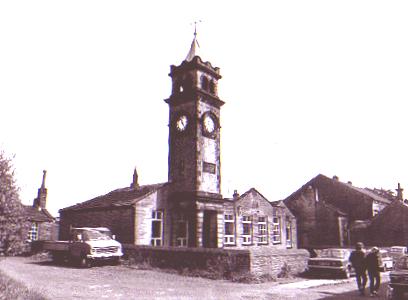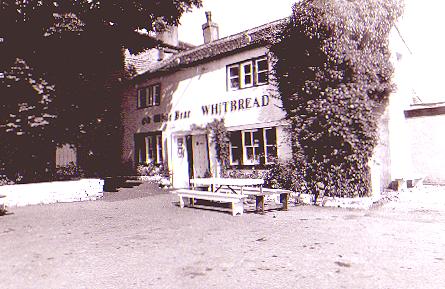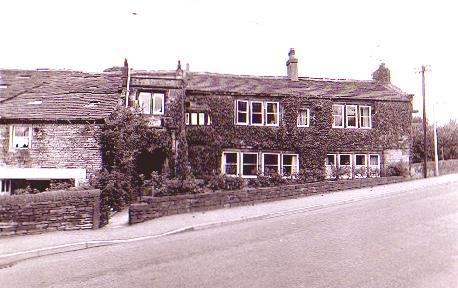
Though close in proximity to two major roads, Norwood Green is a haven of rural tranquillity. The Calderdale Way passes along its main street, bound for Bailiff Bridge and Brighouse. At the end of Sowden Lane turn left, first observing on the right the Jubilee Clock Tower, which was built in 1897 by the family of Ephraim Ellis to comemmorate Queen Victoria's Diamond Jubilee. Known also as the Ellis Memorial Clocktower, it is Norwood Green's most distinctive landmark. Proceeding down the village street, which is surrounded by the green areas that give the village its name, the OLD WHITE BEAR INN is reached on the left. The inn is named after a ship which formed part of the English fleet built to fight the Armada in 1588. The vessel weighed 900 tons and carried a complement of 340 mariners, 30 gunners and 120 soldiers. Perhaps it was one of these men who was responsible for the establishment of the inn. There is a legend that ships timbers from the 'White Beare' are incorporated into the fabric of the inn. Who knows? In the nineteeth century the inn was owned by one Jonas Bateman, brother of John and William Bateman of Bailiff Bridge, who invented the cross dyeing process. John lived at the Lower Wyke Moravian settlement, and Norwood Green was one of the first Moravian preaching stations after they came to Yorkshire. Once upon a time the White Bear had its own brewhouse in an adjoining barn (Now demolished to make way for a carpark). The brewing apparatus is preserved in the Shibden Hall Folk Museum, Halifax.

THE OLD WHITE BEARE INN NORWOOD GREEN..
From the White Bear we move on to a junction of roads at the war memorial. The route continues along Station Road towards Wyke, rejoining the bottom of Judy Woods on the left, but if desired, a small diversion down towards the Leeds and Whitehall Road will lead you to LOWER ROOKES HALL with its lovely sundial and entrance porch. The present hall is largely seventeenth century, but the original hall was built by the Rookes family, and it is recorded that one Jordan De Rooks lived there as early as 1187 and he was followed by the family of Richard Rooks until 1272. This makes it one of the oldest living sites in the area. The Rookes of Royds Hall came from this place and it remained in the possession of that family until 1529.

LOWER ROOKES HALL NORWOOD GREEN
Retracing our steps back to the war memorial we pass along Station Road, passing the excellent PEAR TREE INN on the right. Opposite the Pear Tree, in fields on the other side of the road, once stood the NORWOOD GREEN COLLIERY. No trace now remains. This closed down in the late 1950's. An old miner who once worked there reported that the seams at Norwood Green were frequently waterlogged, and you often had to work waist-deep in water. This possibly explains its early demise.
Soon we arrive at the bottom of the woods with the railway line to Bradford on our right. Here near the railway house, refreshments are sometimes available, before we turn left up into Judy Woods, this portion of which is known as
LOW WOOD
Entering the wood, our path crosses the stream along a high embankment leading to an artificial cutting, through which a small stream flows in winter. This is the line of an old coal tramway which once led to the Low Moor Ironworks, which originally owned (and mined) all of these woodlands. Nearby the beck enters a long, dark tunnel which takes it under the road and the railway in the direction of Bailiff Bridge. Just outside Bailiff Bridge it is joined by another beck which has been running parallel with it through the smaller Shelf and Ox Heys woods. Beyond Bailiff Bridge it becomes known as the Clifton Beck, eventually emptying into the Calder near Brighouse.
Previous Page
Next Page





copyright © Jim Jarratt 2002
From the White Bear we move on to a junction of roads at the war memorial. The route continues along Station Road towards Wyke, rejoining the bottom of Judy Woods on the left, but if desired, a small diversion down towards the Leeds and Whitehall Road will lead you to LOWER ROOKES HALL with its lovely sundial and entrance porch. The present hall is largely seventeenth century, but the original hall was built by the Rookes family, and it is recorded that one Jordan De Rooks lived there as early as 1187 and he was followed by the family of Richard Rooks until 1272. This makes it one of the oldest living sites in the area. The Rookes of Royds Hall came from this place and it remained in the possession of that family until 1529.

LOWER ROOKES HALL NORWOOD GREEN
Retracing our steps back to the war memorial we pass along Station Road, passing the excellent PEAR TREE INN on the right. Opposite the Pear Tree, in fields on the other side of the road, once stood the NORWOOD GREEN COLLIERY. No trace now remains. This closed down in the late 1950's. An old miner who once worked there reported that the seams at Norwood Green were frequently waterlogged, and you often had to work waist-deep in water. This possibly explains its early demise.
Soon we arrive at the bottom of the woods with the railway line to Bradford on our right. Here near the railway house, refreshments are sometimes available, before we turn left up into Judy Woods, this portion of which is known as
LOW WOOD
Entering the wood, our path crosses the stream along a high embankment leading to an artificial cutting, through which a small stream flows in winter. This is the line of an old coal tramway which once led to the Low Moor Ironworks, which originally owned (and mined) all of these woodlands. Nearby the beck enters a long, dark tunnel which takes it under the road and the railway in the direction of Bailiff Bridge. Just outside Bailiff Bridge it is joined by another beck which has been running parallel with it through the smaller Shelf and Ox Heys woods. Beyond Bailiff Bridge it becomes known as the Clifton Beck, eventually emptying into the Calder near Brighouse.
Previous Page
Next Page





copyright © Jim Jarratt 2002
Retracing our steps back to the war memorial we pass along Station Road, passing the excellent PEAR TREE INN on the right. Opposite the Pear Tree, in fields on the other side of the road, once stood the NORWOOD GREEN COLLIERY. No trace now remains. This closed down in the late 1950's. An old miner who once worked there reported that the seams at Norwood Green were frequently waterlogged, and you often had to work waist-deep in water. This possibly explains its early demise.
Soon we arrive at the bottom of the woods with the railway line to Bradford on our right. Here near the railway house, refreshments are sometimes available, before we turn left up into Judy Woods, this portion of which is known as
LOW WOOD
Entering the wood, our path crosses the stream along a high embankment leading to an artificial cutting, through which a small stream flows in winter. This is the line of an old coal tramway which once led to the Low Moor Ironworks, which originally owned (and mined) all of these woodlands. Nearby the beck enters a long, dark tunnel which takes it under the road and the railway in the direction of Bailiff Bridge. Just outside Bailiff Bridge it is joined by another beck which has been running parallel with it through the smaller Shelf and Ox Heys woods. Beyond Bailiff Bridge it becomes known as the Clifton Beck, eventually emptying into the Calder near Brighouse.
Previous Page
Next Page



